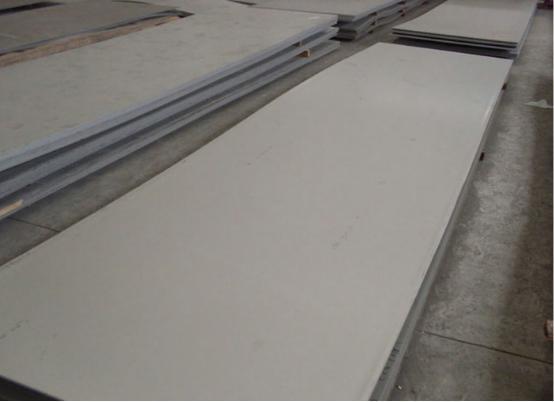309S Stainless Steel Plate
Description
309S stainless steel is a highly alloyed austenitic stainless steel used for its excellent oxidation resistance, high-temperature strength, and creep resistance. The lower nickel content of Stainless Steel 309, compared to Stainless Steel 310, improves its resistance to hydrogen sulfide (H2S) attack at high temperatures. It is tough and ductile and can be readily fabricated and machined. SS 309S is the low-carbon version, and is recommended for applications where sensitization and subsequent corrosion by high temperature gases or condensates during shutdown may pose a problem. Stainless Steel 309S is used for its high-temperature oxidation resistance and/or resistance to H2S attack for applications such as furnace parts, firebox sheets, high-temperature containers, catalytic converters, and exhaust systems.

Excellent oxidation resistance
High temperature strength
High creep resistance
Tough and dectile
Readily fabricated and machined
Resistant to hydrogen sulfide attack at high temperatures
Applications
Furnace parts
Muffles, Retorts
Firebox sheets
High temperature containers
Catalytic converters
Exhaust systems
Radiant Tubes
Fluidized bed coal combusters
Petroleum refineries and steam boilers
Thermowells
Carbon Saggers
Paper Mill Equipment
Power boiler tube hangers
Anchor bolts
Gladd forming equipment
Food processing industry
Corrosion resistance
Types 309 and 309S provide excellent general corrosion resistance. They are more resistant to marine
atmospheres than Type 304. They exhibit high resistance to sulfite liquors and are useful for handling
nitric acid, nitric-sulfuric acid mixtures, and acetic, citric, and lactic acids.
These materials are generally considered heat-resisting alloys. Their destructive scaling temperature
is about 2000 °F (1093 °C). They exhibit good scaling resistance in both continuous and intermittent
service, but the alloys should not be used above 1800 °F (982 °C) for intermittent service.
Formability
Types 309 and 309S stainless steels can be roll formed, stamped and drawn readily. In process annealing
is sometimes required to reduce hardness and restore ductility. Type 309 is extremely stable and will
remain nonmagnetic when cold worked. Its lower elongation makes this grade somewhat more difficult
to form than other 300 series austenitic grades.
Weldability
The austenitic class of stainless steels is generally considered to be weldable by the common fusion and
resistance techniques. Special consideration is required to compensate for a higher coefficient of thermal
expansion to avoid warping and distortion. Type 309 is generally considered to have weldability.
Heattreatment
These alloys are not hardenable by heat treatment.
Annealing: Anneal at 1900 – 2050 °F (1038 – 1121 °C), then water quench or rapidly air cool.

Excellent oxidation resistance
High temperature strength
High creep resistance
Tough and dectile
Readily fabricated and machined
Resistant to hydrogen sulfide attack at high temperatures
Applications
Furnace parts
Muffles, Retorts
Firebox sheets
High temperature containers
Catalytic converters
Exhaust systems
Radiant Tubes
Fluidized bed coal combusters
Petroleum refineries and steam boilers
Thermowells
Carbon Saggers
Paper Mill Equipment
Power boiler tube hangers
Anchor bolts
Gladd forming equipment
Food processing industry
Corrosion resistance
Types 309 and 309S provide excellent general corrosion resistance. They are more resistant to marine
atmospheres than Type 304. They exhibit high resistance to sulfite liquors and are useful for handling
nitric acid, nitric-sulfuric acid mixtures, and acetic, citric, and lactic acids.
These materials are generally considered heat-resisting alloys. Their destructive scaling temperature
is about 2000 °F (1093 °C). They exhibit good scaling resistance in both continuous and intermittent
service, but the alloys should not be used above 1800 °F (982 °C) for intermittent service.
Formability
Types 309 and 309S stainless steels can be roll formed, stamped and drawn readily. In process annealing
is sometimes required to reduce hardness and restore ductility. Type 309 is extremely stable and will
remain nonmagnetic when cold worked. Its lower elongation makes this grade somewhat more difficult
to form than other 300 series austenitic grades.
Weldability
The austenitic class of stainless steels is generally considered to be weldable by the common fusion and
resistance techniques. Special consideration is required to compensate for a higher coefficient of thermal
expansion to avoid warping and distortion. Type 309 is generally considered to have weldability.
Heattreatment
These alloys are not hardenable by heat treatment.
Annealing: Anneal at 1900 – 2050 °F (1038 – 1121 °C), then water quench or rapidly air cool.
TOP




